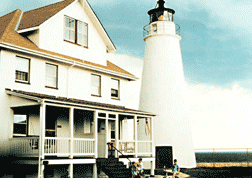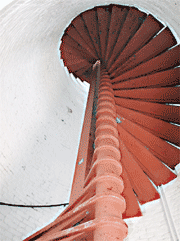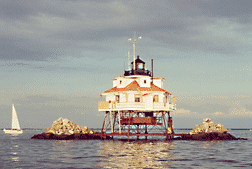 |
||||||||||
|
||||||||||
|
||||||||||
New Lives for Old LighthousesThe light’s on and you can come callingby Margaret Tearman
Anythin’ for a quiet life, as the man said when he took the situation at the lighthouse.–Charles DickensChesapeake Bay has lured sailors for hundreds of years, and her lighthouses guided them through dark nights and across stormy waters to safe harbor. The old lighthouses, icons of maritime culture and history, have lost their way in the sea of new navigational technology. Now, lights in Calvert and Anne Arundel counties are getting new leases on life. Lighthouse for RentThe light from Cove Point is still guiding sailors on mid-Chesapeake Bay, though it hasn’t been manned by human hands since 1986 when the last lighthouse keeper moved out and computer automation moved in. Finally, the old lighthouse is being readied for some new tenants. Cove Point came to Calvert Marine Museum from the U.S. Coast Guard in 2000. Since then it has been vacant except for museum visitors who arrive by tour bus and stay only for an hour or two. The museum has decided it’s time to bring new life into the old place. “We plan to repair and restore the lighthouse,” says Vanessa Gill, the museum’s development director. “Once the work is completed we will open up the keeper’s house as a weekly vacation rental.” The museum anticipates the for rent sign will go up as soon as 2008. Those who choose a lighthouse vacation will relive — one week at a time — a bit of Chesapeake’s maritime history. Anything for the Quiet LifeBuilt in 1828 by John Donahoo, Cove Point is Maryland’s oldest continuously operating lighthouse and is listed on the National Register of Historic Places. It’s located on one of the narrowest parts of Chesapeake Bay to safely guide ships onto the Patuxent River. Before computers came along, it took human hands to keep the light on and the house in order. It was a job for a lighthouse keeper. But not for a gregarious soul. The keepers were often isolated from outside human contact for long periods of time as lighthouses were commonly built where most needed — in remote areas along dangerous coasts, exposed to harsh weather. It took a rugged spirit with a strong back to keep the light shining 24 hours a day, every day. Light towers typically have a steep, narrow circular stairway leading up to the light beacon. The lenses and lamps required daily cleaning, and the keeper had to lug cleaning supplies and tools up — and back down — the steep tower, without fail, every day. Fair weather or foul, keepers were expected to keep the light shining. If a keeper became ill, it was his responsibility to find a fill-in to take over until he recovered. No temp services to call back then, so families were job sharers as well as comforts. Then there was the nightly watch. Keepers were expected to wake at regular intervals throughout the night to make sure the light was burning and the signal timing accurate.
Museum Quality LodgingToday’s stay in a lighthouse will be a bit less arduous. But it will not be entirely duty free. “We will ask our renters to be temporary lighthouse keepers,” Gill says. “We like to think their lighthouse vacation will be enhanced by this unique opportunity to experience a bit of hands-on history.” The temporary keepers won’t be asked to climb steep stairways with a bucket and mop, but they will be asked to take on less demanding responsibilities, such as recording daily weather and tide observations. But they won’t have to worry about keeping the light on. It will remain automated, run by computer out of the Coast Guard’s operation center in Baltimore. The Cove Point keeper’s house is structurally sound, but before it can receive guests, there are extensive renovations to be done. The interior needs all new wiring and plumbing, paint and polish. But modern necessities will not replace character. The museum plans to retain the building’s original features like the heart-pine wooden floors, railings and banisters and the old cast-iron radiators. Outside, plans call for new windows and a new, metal roof. The building’s distinctive “eyebrow” dormer windows, removed some time ago, will be restored and reinstalled. When work has been completed and the vacancy sign is lit, the museum is banking on its new guest house to be self-sustaining, bringing in enough rent throughout the year to cover operating costs. “We want to offer visitors the opportunity to experience a unique piece of Chesapeake Bay history in all seasons,” Gill says. Popular in New England and the Great Lakes, lighthouse vacations are new to Maryland. Cove Point will be the only lighthouse on the Chesapeake Bay with a keeper back in the house — if just for one week at a time. For details visit the museum’s website: www.calvertmarinemuseum.org
Day Tripping the Light FantasticIf a lighthouse vacation is more than you’re looking for, another Chesapeake treasure may be your destination. Thomas Point Shoal Lighthouse, built in 1875 and today a National Historic Landmark, is now receiving guests. A mile and a half in Chesapeake Bay at the mouth of the South River, Thomas Point is the last screwpile lighthouse still in its original location. Annapolis and the Lighthouse Society acquired it from the Department of the Interior in 2004 and has since been busy with extensive restorations to the historic light. Now a long-hoped for plan has been realized. The lighthouse has opened for limited guided tours. “This is a rare opportunity to get a guided tour inside of this icon,” says Jeff Holland, director of Annapolis Maritime Museum, which oversees Thomas Point interpretation and tours. “Now visitors will have a chance to see the restoration progress over the next few years.” Thomas Point doesn’t offer overnight accommodations, but getting there offers adventure. Visitors up for the challenge must board a boat from a high dock, chance heavy seas for the 30-minute boat ride to the lighthouse, climb off the boat to another dock, ascend a steep ladder, then crawl through a small trap door to the lighthouse deck. “There are no facilities available on the boat or the lighthouse,” cautions Holland, who advises those who may not be physically able to handle the challenge to stay on dry land. Visitors must be at least 12 years old and four feet tall. Space is limited and reservations are required: 800-690-5080; www.chesapeakelights.com. |
||||||||||
|
||||||||||
|
|
||||||||||
|
© COPYRIGHT 2007 by New Bay Enterprises, Inc. All rights reserved. |
||||||||||


